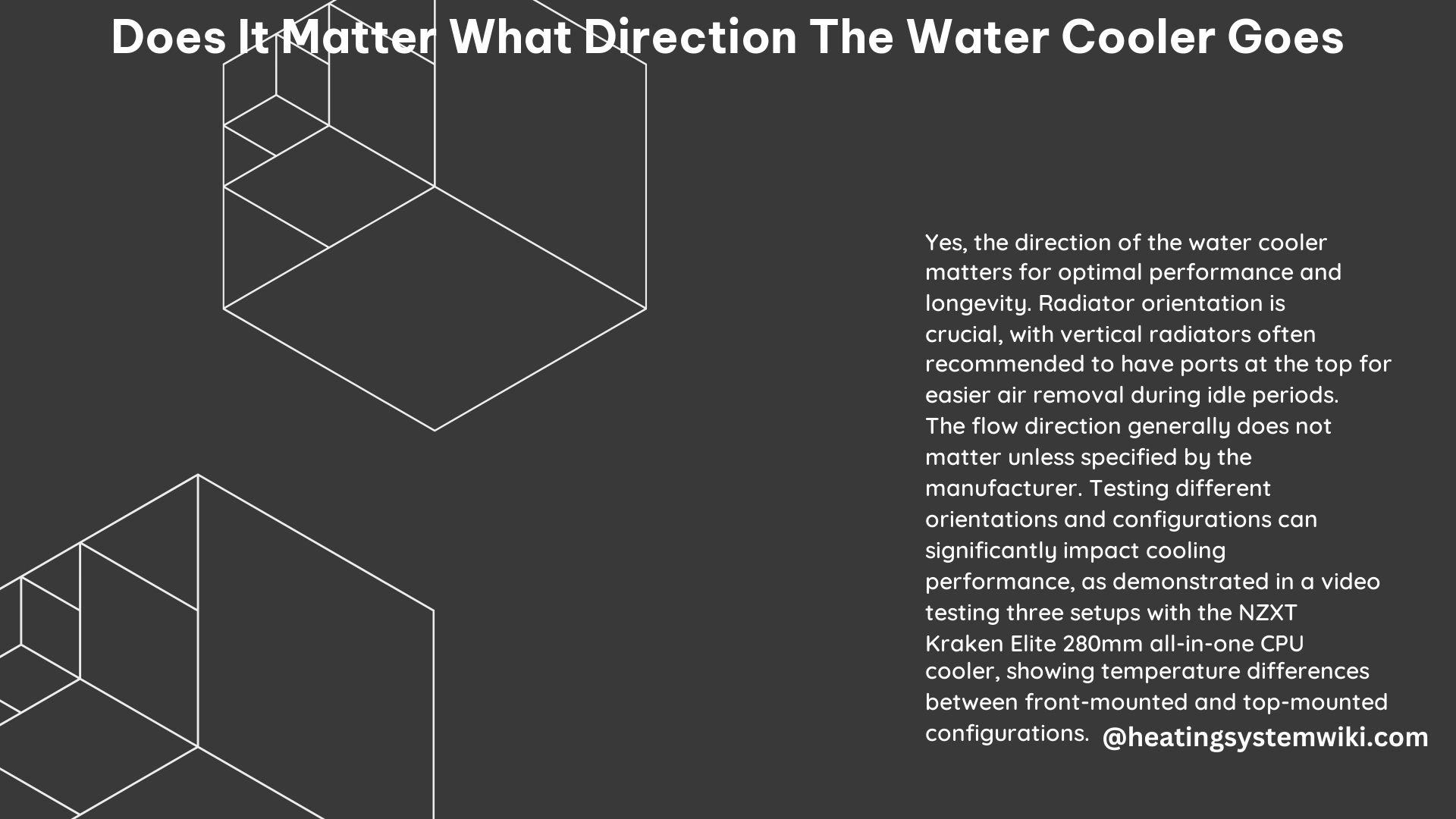The direction of the water cooler in a PC’s cooling system is often a topic of debate among enthusiasts and DIY builders. While the overall impact on cooling performance may not be significant in most cases, there are several factors to consider when deciding the orientation of the water cooler. This comprehensive guide will delve into the technical details and provide a hands-on playbook for optimizing the water cooler’s direction for maximum efficiency.
Radiator Orientation
The orientation of the radiator is a crucial factor to consider when setting up a water cooling system. The type of radiator used can have a significant impact on the optimal orientation.
High-Performance Radiators
High-performance radiators, such as those from Hardwarelabs, often have specific orientations recommended by the manufacturer for optimal cooling performance. These radiators may have asymmetrical designs or internal flow paths that require a particular orientation to achieve the best results.
For example, the Hardwarelabs GTS 360 radiator has a recommended orientation with the inlet and outlet ports at the top. This orientation helps with air removal and bleeding the system when the pump is off or the loop is idle.
Vertical vs. Horizontal Orientation
In general, vertical radiators with the inlet and outlet ports at the top are commonly recommended for water cooling systems. This orientation helps with air removal and bleeding the system, which is crucial when the pump is off or the loop is idle.
When it comes to draining the system, a radiator with the ports at the bottom is often preferred, as it makes the draining process easier.
Radiator Dimensions
The dimensions of the radiator can also play a role in the optimal orientation. Taller radiators may perform better in a vertical orientation, while wider radiators may benefit more from a horizontal orientation, depending on the case layout and airflow considerations.
Flow Direction

The flow direction in a water cooling system is another factor to consider, but it rarely has a significant impact on cooling performance unless specified by the manufacturer.
Inlet and Outlet Ports
Some water blocks and radiators have specific inlet and outlet ports, and connecting them in the wrong order can result in higher temperatures. It is essential to follow the manufacturer’s instructions for the specific water cooling components used in the loop.
Manufacturer Recommendations
While the flow direction may not matter in most cases, it’s always a good idea to check the manufacturer’s recommendations for the water cooling components in your system. Some high-end or specialized products may have specific flow requirements for optimal performance.
Water Block Orientation
The orientation of the water block is generally less critical than the radiator orientation, as long as the block is properly mounted and making good contact with the CPU.
Specific Orientations
Some water blocks may have specific orientations recommended by the manufacturer, such as the inlet and outlet ports being positioned in a certain way. In these cases, it’s essential to follow the manufacturer’s instructions to ensure proper cooling performance.
Flexible Orientation
However, in most cases, the water block orientation does not have a significant impact on cooling performance. As long as the block is securely mounted and the thermal interface material is applied correctly, the orientation can be adjusted to fit the specific case layout and plumbing requirements.
Fan Direction
The direction of the fans on the water cooler can have an impact on the overall cooling performance and airflow within the case.
Intake vs. Exhaust
The fans on a water cooler can be configured to either draw air into the case (intake) or push air out of the case (exhaust). The choice between intake and exhaust depends on the user’s preference and the overall case airflow configuration.
Airflow Considerations
Regardless of the fan direction, it’s essential to ensure that the airflow is directed towards the radiator. Obstructed or restricted airflow can negatively impact the cooling performance of the water cooler.
Case Airflow
The overall airflow within the case should also be considered when deciding the fan direction. Ensuring adequate airflow and preventing hot air recirculation is crucial for maintaining optimal cooling performance.
Conclusion
In summary, the direction of the water cooler in a PC’s cooling system does not have a significant impact on cooling performance in most cases. However, considering factors such as radiator orientation, flow direction, water block orientation, and fan direction can help optimize the system for maximum efficiency and stability.
By following the manufacturer’s recommendations, understanding the impact of each component’s orientation, and ensuring proper airflow within the case, you can ensure that your water cooling system is operating at its best.
References:
- Debunking Water Cooler Orientation! Must Watch | Gears and Tech – https://www.youtube.com/watch?v=7PHJSYzEeFE
- Does flow direction matter? waterblock flow direction? – Overclock.net – https://www.overclock.net/threads/does-flow-direction-matter-waterblock-flow-direction.1007942/
- Where should you install your AIO liquid cooler? The best … – YouTube – https://www.youtube.com/watch?v=qQcyYHGtArs
- does it matter which way the coolant goes in the radiator … – Reddit – https://www.reddit.com/r/watercooling/comments/rp1fjj/does_it_matter_which_way_the_coolant_goes_in_the/
- Which way should my watercooler face? – Tom’s Hardware Forum – https://forums.tomshardware.com/threads/which-way-should-my-watercooler-face.3411475/
